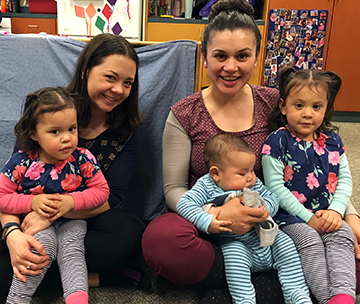 |
| Tanya with her children and therapist, Katelyn (at left). |
Two year old twins Victoria and Valeria toddle shyly into the busy classroom. It is a Monday morning in early spring, and this is their third visit to a Spanish-speaking playgroup structured specifically for children with special needs.
Victoria, the more reserved of the two girls, grasps her mother Tanya’s hand and gazes silently around the room as her peers, their parents, and teachers mingle and greet one another. Valeria hesitates for only a few moments before moving deliberately towards a table full of barnyard toys.
Katelyn, their speech-language pathologist, smiles at Tanya. “I can’t believe how much progress they’ve made in just a few weeks!” she says. Tanya nods. “It was really challenging at first. I remember at the end of the art project on that first day, they both started crying and screaming because they didn’t want to be redirected to another activity. That was pretty common for them!”
The girls were born prematurely at 26 weeks. “They were my first children [son Tomás was born in January] and I wasn’t even aware they weren’t reaching their milestone until my pediatrician mentioned it.” Referred for physical therapy services at the age of six months, the first goal was to build their weak muscle tone. “They’d be lying down, unable to do much of anything at all. Once they were able to move on their own and become more independent, they were a lot happier.”
Both girls also struggled with communication. “For Valeria, who really needs to move and be physical, learning how to give her more sensory input was helpful,” says Tanya. “When she gets kind of crazy moving around too much, I say to her, “Hug me! Hug me! Tighter!” We both love it and it seems to calm her down.” As for Victoria, learning to sign helped her get her needs met. “She loved it, and she’d sign for what she wanted instead of crying.”
As Victoria and Valeria got older and became more mobile, Tanya was faced with a new challenge – keeping her daughters safe. “Outings have been challenging,” says Tanya. “They are learning to pay attention to ‘stop,’ ‘no,’ and ‘wait’ but I’ve learned some strategies from Katelyn that help. I give each of them a grocery item to carry and be responsible for, and I give Valeria the heavier stuff because she likes carrying weight. I involve both of them – for example, we all look for the bananas together.”
Katelyn is quick to note how diligently Tanya applies what she has learned in therapy at home. “Tanya is typically very well prepared for our therapy sessions – she sets out a little table with activities laid out, applies masking tape on the floor for a game, or pulls out a sensory bin that she built. She uses these tools with the girls all the time. I see her really putting our recommendations to work – and in fact, I learn from her all the time!”
“If you follow what’s being recommended and work with your children, you will see results so fast!” says Tanya. “It’s amazing. Every week, they are learning and doing something different.”
Katelyn says that the key to success is to incorporate therapy into daily routines. “I’ll often sit down with parents and say, ‘What do you absolutely need to get done in your day, and then how can we change that just a little to incorporate some therapy?’ We help families develop a toolkit of strategies they can use with their child. If families don’t have access to a toolkit like that, it may be harder for them to see progress quickly.”
By the end of class, both girls are smiling. “They are continuing to make great progress,” says Katelyn, “and it’s because of mom’s hard work!”